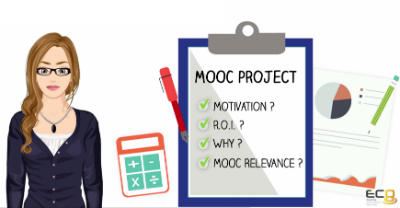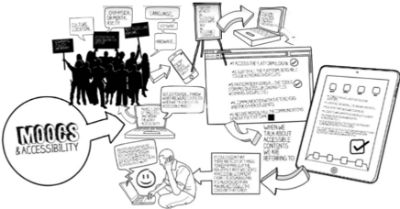
To MOOC or Not to MOOC?. There are plenty of great reasons to embrace MOOCs. Teaching a MOOC is a great experience with lots of practical value. Here are some reasons to consider teaching a MOOC:
Acade mic research
mic research
Research can be a catalyst for teaching a MOOC. This is a tough area because MOOCs are so new, there are almost limitless avenues to explore.
MOOCs give teachers a chance to see how other teachers work. There is a value of learning about pedagogy from observing other teachers. If they are good, you might decide to emulate them; if they are bad, you might try to avoid repeating their mistakes.
Professional experience
It allowed you to observe how they are designed and taught, and to learn from how other participants react.
On line learning often prevents the instructor from being as spontaneous as they can in a face-to-face class, and although it requires a lot of pre-planning of material, instructors can still find creative ways of responding to participant interests and requests. You can develop new skills about how to make a video feel more interactive and dynamic for your students.
By comparing the four different MOOCs, you can see the “best practices” of MOOC pedagogy used across the courses.
Re-live the student experience
Some instructors want to teach a MOOC many times over with the goal of creating a super-efficient, super-effective learning experience.
MOOCs allow teachers to find out what it is like to be on the receiving end of eLearning today. You may be using some technology in your teaching, but you may not have experienced this learning as a student before.Re-live the student experience – on line!
Learn by doing
A very common purpose for wanting to teach a MOOC is simply that—to teach a MOOC. Educators are inquisitive by nature and their interest in MOOCs is an extension of that curiosity.
To learn something new, some people would traditionally invest time and effort into reading a book. Others would browse the Internet for resources.
However, if you prefer social learning to the solitary pursuit of reading a book (after all, as an adult learner and teacher, you probably already read a lot of books and other material as it is!), or if you feel you need a little bit of scaffolding when dipping into a new topic, MOOCs are an option. So, you can learn something new in a structured way.
Whereas previously, you could follow an entire course’s lectures by downloading lectures from iTunes U, for example, the benefit of a MOOC is that you can do assignments or quizzes to validate your learning, but doing the assignments forced you to reflect on and analyses the topics in ways I would not have done independently.
Socialize the learning experience
The forums and peer assessments can also socialize the learning experience for you, enriching the depth and breadth of your learning.
Find well-chosen (mostly free) resources on a topic or sub-topic.
While you can find all sorts of discussion forums on line for different interest groups, those on MOOCs have some of the most diverse groups of people you can ever see.
The discussions can range from directly related to the class syllabus to completely learner-generated topics. You can join several community conversations about topics that interest you.
Because the courses are time-limited, the conversations can be more intense (time-wise) than on other discussion forums where responses can take weeks or months.
You will find that your classmates dove deep into how that related to their experiences.
Depending on the MOOCS you could find that many of the community discussions are focused on educational and psychological aspects.
Personal learning goals
MOOCs vary widely in quality. There is no reason to dismiss MOOCs simply because they are on line, are delivered to the masses or are free. And there is also no reason to glorify a MOOC based on these same characteristics.
As adult learners with personal learning goals, teachers can approach MOOCs in an intentional manner and make use of their potential.
I would suggest that any educator with even a remote interest in e learning for professional development should not miss out on this opportunity. I hope to encourage my own students (themselves teachers) to try out a MOOC. Meanwhile, happy MOOCing!
MOOC is really all about you. If you would like to become the instructor of your own MOOC, after completed “sMOOC Step by Step” please apply to “Become an e-teacher”. We can’t wait to see what you create. – Team UoMan.
Note: Article idea and some texts are taken from:
http://blog.canvaslms.com/blog/bid/310026/Why-teach-a-MOOC#sthash.hkZp87U1.dpbs and http://moocnewsandreviews.com/5-reasons-teachers-should-dip-into-moocs-for-professional-development-2



